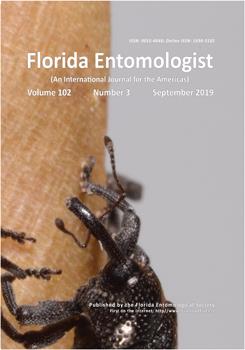Empoasca kraemeri Ross & Moore (Hemiptera: Cicadellidae) is a phytophagous species widely found in tropical and subtropical regions of the world. This species is associated with several agricultural crops, where they are established due to food supply and favorable developmental conditions. The objective was to record the occurrence and damage caused by E. kraemeri in sweet potato germoplasm in Diamantina, Minas Gerais State, Brazil. Physical injuries were caused by E. kraemeri penetrating the stylet into the phloem of the plant, creating chlorotic spots on the leaves with posterior necrosis. This insect has the potential to cause severe damage. Thus, it is important to include E. kraemeri in integrated pest management programs for the sweet potato.
The sweet potato (Ipomoea batatas (L.) Lam., Convolvulaceae) is cultivated throughout the national territory of Brazil, presenting great phenotypic and genotypic diversity (Santos et al. 2018). The plant has a wide spectrum of potential uses, making it a species of economic interest, mainly for developing countries with food shortages. Therefore, sweet potato is grown in more than 100 countries, making it 1 of the world's 7 most important sources of food (FAO 2016). Cultivation can be designated for animal and human consumption, cosmetic, fabric, paper, preparation of adhesives, and alcohol fuel industries, as well as raw materials for food (Cardoso et al. 2005; Castro et al. 2018; dos Santos et al. 2018).
Among the most damaging sweet potato pests in Brazil are Bedellia somnulentella Zeller (Lepidoptera: Bedelliidae), Diabrotica speciosa Germar (Coleoptera: Chrysomelidae), Euscepes postfasciatus Fairmaire (Coleoptera: Curculionidae), Megastes pusialis Snellen (Lepidoptera: Crambidae), and the mites Tetranychus ludeni Zacher and Tetranychus urticae Koch (Acari: Tetranychidae) (Soares et al. 2012; dos Santos et al. 2018), all with the capacity to cause production losses.
The objective of this study was to report, for the first time, the attack and impact of the Empoasca kraemeri Ross & Moore (Hemiptera: Cicadellidae) on sweet potato germplasm in Brazil.
Adult and immature E. kraemeri (Fig. 1A–D) were observed in the Vegetable Crops sector at the Universidade Federal dos Vales do Jequitinhonha e Mucuri (UFVJM) in Diamantina, Minas Gerais State, Brazil (18.166600°S, 43.500000°W; 1,387 masl). The insects were detected between Sep and Dec 2017 in a bank of sweet potato germplasm, grown in soil beds within a greenhouse. The mean air temperature and relative air humidity of these months were 20.6 °C and 66.7% (INMET 2018), respectively. Physical injuries were caused by E. kraemeri penetrating the stylet into the phloem of the plant, creating chlorotic spots on the leaves and necrosis (Fig. 1C, D).
Adults of E. kraemeri were collected and killed in 70% alcohol, and taken to the Agricultural Entomology Laboratory of the University to confirm the identification. The identified samples were deposited in the entomological collection of the Museum of Entomology of the University.
Empoasca kraemeri is widely distributed in tropical and subtropical regions of the world (Singh & Allen 1979). This pest occurs in the abaxial and adaxial leaf surfaces. In the third instar, the nymph can easily be seen and identified by its rapid lateral movement. Adults of E. kraemeri are green, and measure about 4 mm in length. The mean longevity of these adults is 60 d (Gallo et al. 2002). The egg incubation period is about 10 d, and the immature period lasts between 8 and 10 d (Gallo et al. 2002). Higher infestations may lead to changes in plant growth, which demonstrate downward facing leaf edges with reduced size (Boiça Júnior et al. 2000).
The species was observed attacking other crops with economic importance, ultimately causing damage, such as Jatropha curcas L. (Euphorbiaceae) (Laviola et al. 2010), Manihot esculenta Crantz (Euphorbiaceae) (Pamplona et al. 2009), Phaseolus vulgaris L. (Fabaceae), and Ricinus communis L. (Euphorbiaceae) (Santos et al. 2009), all records for Brazil. There is also a report of E. kraemeri attacking sweet potatoes in Peru (Langlitz 1964).
The geographic record of the presence of phytophagous species and the identification of their hosts are important for the design of local strategies for integrated pest management (IPM) (Pires et al. 2011). This is the first report of E. kraemeri damaging I. batatas, in the municipality of Diamantina (average temperature of 19 °C), and shows that this pest now warrants integration into Brazilian sweet potato pest monitoring programs.
The authors thank the Brazilian agencies “Conselho Nacional de Desenvolvimento Científico e Tecnológico (CNPq)” and “Fundação de Amparo à Pesquisa do Estado de Minas Gerais (FAPEMIG)” for scholarships and financial support. This study was financed in part by the “Coordenação de Aperfeiçoamento de Pessoal de Nível Superior (CAPES)” of Brazil, Finance Code 001.






